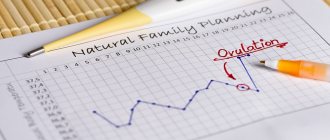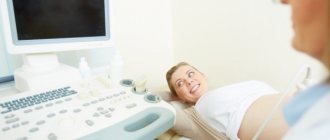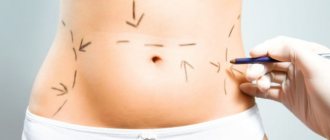Calculating the gestational age is not always such a simple task. Of course, if you know exactly when the only attempt to conceive a child was, then you will not have any special problems with determining the duration of pregnancy, but even in such a situation, not everything is clear. After all, pregnancy does not begin immediately after the end of sexual intercourse.
Knowing exactly the day the pregnancy began is important because most procedures, tests and standards are strictly tied to certain cycles of the perinatal period.
Determining the duration of pregnancy by the date of the last menstruation
The easiest way to determine the duration of pregnancy is to start from the date of the last menstruation. After successful conception, the next menstruation begins in the 4th week of pregnancy. This technique implies that the fertilized egg begins to divide even before ovulation. The method is used when calculating the obstetric gestational age and calculating the expected date of birth (ED) using a special formula. This technique allows you to more or less accurately calculate the timing of a regular menstrual cycle. The gestational age calculated from the date of the last menstruation has an error of two weeks.
How to determine the age of the fetus
Determining the correct gestational age is very important to determine the optimal way to manage a pregnant woman in the event of an abnormal pregnancy. Accurate determination of gestational age is especially important in the case of threatened miscarriage or premature birth, intrauterine growth retardation, or in the perinatal period.
An incorrectly calculated due date can lead to unnecessary actions to hasten the termination of pregnancy: induction of labor or caesarean section. This may also affect the choice of abortion, since the safest option is medical abortion available up to 6-7 weeks, and surgical abortion up to 12 weeks.
At the same time, it should be remembered that the date of birth determined using various methods is approximate, and the degree of deviation is within 3–5%.
Gestational age and hCG
The duration of pregnancy can be determined by the level of human chorionic gonadotropin (hCG) in the blood of the pregnant woman. To do this, you need to donate blood from a vein. As a rule, this method is used in very early stages, when the woman still does not know for sure whether she is pregnant. All popular pregnancy tests are based on the principle of determining the amount of hCG.
So, in the end, we can conclude that the most accurate method for determining the gestational age is ultrasound, but in order to determine the gestational age as correctly as possible, it is necessary to use a set of measures.
Knowing the day of conception and early ultrasound data allows you to reliably calculate the gestational age. Often, the entire combination of these methods is used to determine the gestational age.
You can find many interactive pregnancy calculators on the Internet where you can calculate your due date week by week and track your baby's development.
Changes in the female body and fetal development by trimester
The female body undergoes serious restructuring during gestation. Each trimester brings new physiological changes and increases the risk of developing certain pathologies.
First trimester
The first trimester of gestation is the most difficult period of pregnancy. When a new life is born, all organs and systems begin to function completely differently. So what changes occur in a woman’s body?
- The ovary forms the corpus luteum, which produces large quantities of progesterone. This hormone creates the most favorable conditions for implantation of a fertilized egg into the endometrium of the uterine cavity.
- The chorion of the embryo begins to produce the hormone hCG, which maintains the functionality of the corpus luteum.
- The pituitary gland increases the production of prolactin. Thanks to this, the fat cells of the mammary glands are replaced with secretory ones - this is how the body prepares for breastfeeding. In addition, the hormone regulates the functioning of a woman’s adrenal glands and affects the development of the embryo’s respiratory system.
- Immunity decreases, which increases the risk of developing inflammatory processes and exacerbation of chronic diseases that were observed in a woman before pregnancy.
- The excitability of the central nervous system increases. In this regard, a woman experiences drowsiness, irritability, and fatigue.
- Starting from the 5th week of gestation, most pregnant women experience toxicosis, which is accompanied by nausea and changes in eating behavior.
In addition, pregnant women may experience a decrease in visual acuity, a burning sensation and dryness in the eyes. If you have such symptoms, you should definitely consult an ophthalmologist.
The first trimester of gestation is an important stage in the development of the embryo, when all the organs and systems of the unborn baby are formed. The formation of the brain and spinal cord, digestive system, respiratory organs, heart, blood vessels, and endocrine glands occurs. The skeleton, muscle tissue, and genitals are formed. By the end of the first trimester, it becomes possible to determine the gender of the unborn child. The pregnant woman’s condition is improving: toxicosis and irritability disappear.
more about changes in the female body and embryo development in the 1st trimester in our article.
Second trimester
As a rule, the second trimester of gestation is much more stable than the first. Such unpleasant symptoms as nausea and increased fatigue are already behind us. The pregnant woman begins to feel more comfortable. However, the unborn baby continues to develop and grow, which cannot but affect the woman’s physical condition.
It is in the second trimester that women often experience a lack of calcium, which is spent on the needs of the child. A deficiency of this substance can affect the condition of the teeth. It is important to address any dental problems during pregnancy immediately. All body systems are interconnected, and even caries can cause serious inflammatory processes. Read about the features of dental treatment during gestation .
In mid-pregnancy, women have an increased risk of inflammatory diseases of the genitourinary system. This is due to an increase in the size of the fetus and uterus, specific changes in the condition of the mucous membrane of the genital tract and, of course, a decrease in the body’s defenses. Pathologies that were previously unusual for women may occur: pyelonephritis, cystitis, bacterial vaginosis.
In addition, in the second trimester, the load on bones, muscles and ligaments increases. To avoid the development of pathologies of the musculoskeletal system, it is important for a woman to visit an osteopath. How a specialist can help during pregnancy - detailed information in our material .
Physiological changes in the female body in the second trimester include:
- white vaginal discharge, which occurs due to increased secretion of estrogen;
- false contractions caused by “training” contractions of the uterus. They are more characteristic of the 3rd trimester; their presence in the second trimester may indicate a threat of miscarriage;
- enlargement of the abdomen and mammary glands;
- increased sensitivity of the nipples.
How does the fetus develop during the second trimester? He is growing quickly and gaining weight. The musculoskeletal system, immune, respiratory, reproductive, and urinary systems are improved.
complete information about fetal development in the second trimester in our article .
Third trimester
The last trimester of gestation is accompanied by rapid weight gain of the pregnant woman, which is primarily due to the intensive growth of the fetus. During this period, it is very important to carefully monitor body weight and prevent the development of obesity. Being overweight can cause gestational diabetes, a serious disease that often causes fetal abnormalities and difficult births.
In the third trimester, as in the second, the risk of developing inflammatory processes in the genitourinary area is increased. If kidney pathologies occur during pregnancy, then the woman experiences pain in the lower abdomen, symptoms of intoxication of the body (nausea, vomiting, diarrhea), and painful urination.
Inflammatory processes in the genital area may be accompanied by pathological vaginal discharge, itching in the genital area, and pain in the lower abdomen. The appearance of any of the listed symptoms should be a reason to contact a specialist.
At the end of pregnancy, there is a high probability of developing gestosis, which is characterized by a triad of symptoms:
- high blood pressure;
- swelling;
- the appearance of protein in the urine.
An obstetrician-gynecologist treats the disease and monitors the effectiveness of therapy . For the first degree of gestosis, outpatient treatment is allowed. In case of complicated forms of the disease, the pregnant woman is sent to the hospital.
What happens to the unborn baby during the third trimester? Weight and height increase very quickly. The fetus begins to see and hear better, can respond to light and sounds, focus its gaze, smile and move actively.
For more information about how intrauterine fetal development occurs week by week, read our material .
What does science say about conceiving a boy?
To understand how to properly conceive a boy, you need to know the principle of gender formation during egg fertilization. A new person receives half his DNA from his father and half from his mother. Moreover, as is known, women are carriers of the XX chromosome set, and men are carriers of XY. The future sex of the child depends on which father's chromosome is transferred by the sperm that fertilizes the egg. If the sperm carries the Y chromosome, a boy will be born[1].
Pregnancy with your son is the result of many factors coming together, so try not to put too much faith in advice on how to conceive a boy. Today, only the IVF procedure can accurately guarantee the birth of a child of the desired sex, but the selection of an embryo by sex in Russia is carried out only according to indications - in order to exclude any hereditary disease transmitted through the female or male line[2].
What other methods are there to conceive a boy?
They say the following tips may work:
- quit smoking;
- try not to reduce your weight below 55 kilograms;
- give in to your husband - he must be the de facto head of the family;
- don’t worry if you can’t get pregnant for a long time - the longer you don’t succeed, the higher the likelihood that you will have a boy;
- lead a calm, measured lifestyle, avoid stress;
- visualize your future son in every detail.
And finally, a few folk methods to conceive a boy. It’s good if conception occurs in the summer, but it is important that the future father walks the earth barefoot, renewing and strengthening his masculine energy. It is believed that the best time to conceive a son is the morning or afternoon of Monday, Tuesday, Thursday or Saturday.
What diet should you follow to conceive a boy?
Some studies have found a connection between nutrition and the gender of children born. Expectant mothers and fathers who want to give birth to a son are advised to eat foods rich in sodium and potassium - meat, sausages, fish (but not other seafood), potatoes, peas, lentils, beans, mushrooms, cherries, bananas, apricots, oranges, peaches, dates, egg whites, rice, semolina, cookies, dark chocolate. In this case, it is better to give up milk, bread, mineral water with calcium, nuts, greens, green beans, cabbage and salt food more than usual.








